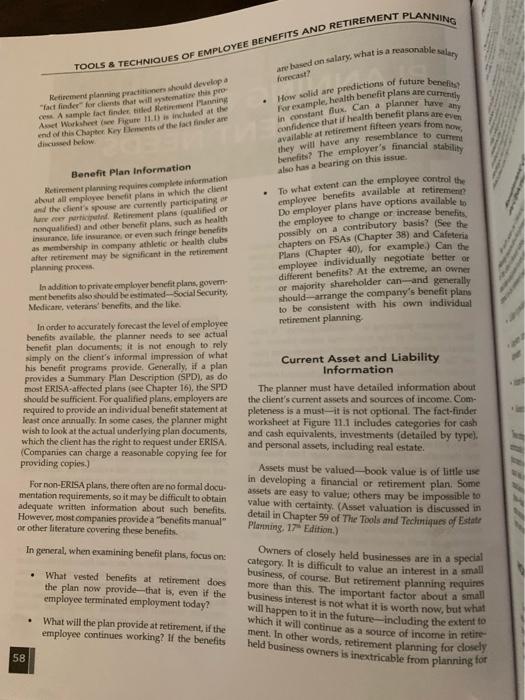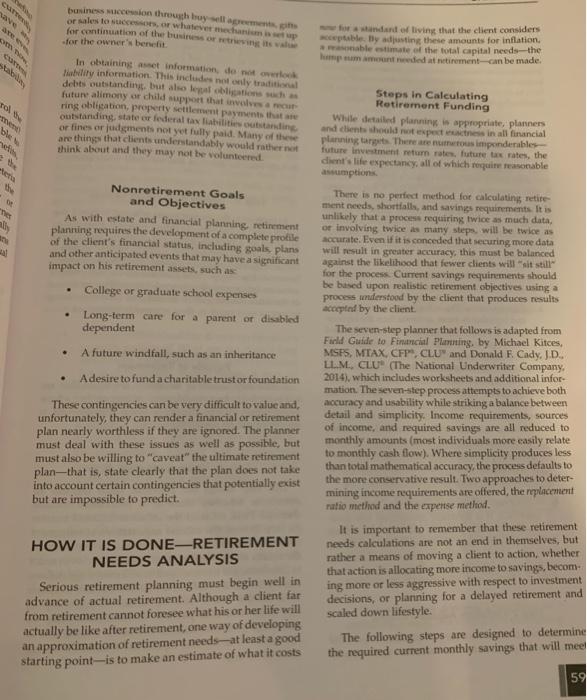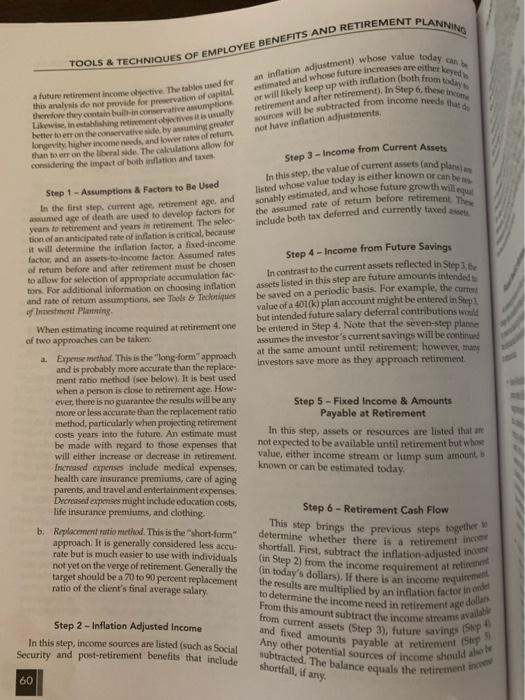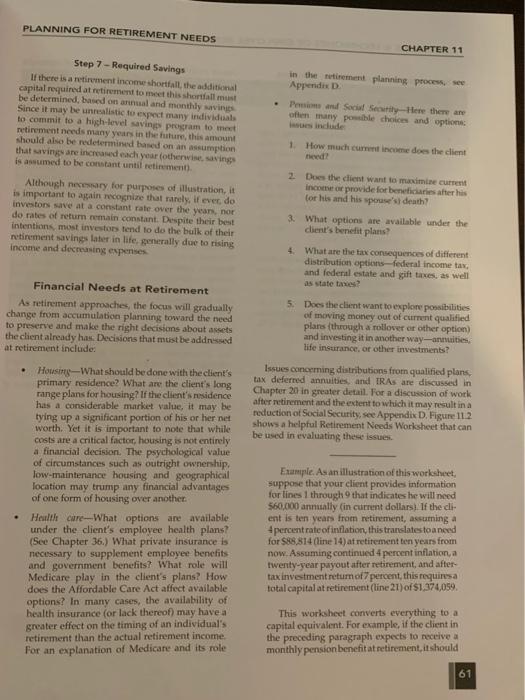Answered step by step
Verified Expert Solution
Question
1 Approved Answer
Discuss the process of retirement needs analysis including the various assumptions and steps in the process. Have an employee example, in detail. Only 250-400 words.
Discuss the process of retirement needs analysis including the various assumptions and steps in the process. 





PLANNING FOR RETIREMENT NEEDS CHAPTER 11 understand the basics of retirement planning-the broad general approaches, the tools and techniques- and where they fit in INTRODUCTION Retirement planning is a critical part of the financial services Industry. With the baby boomers ranging from middle age to retirement age, the number of individu- als with significant savings and retirement planning needs is increasing dramatically. At the same time, the economic and tax complexity of all types of retirement- related financial planning has also increased Retirement planning is interdisciplinary." It com bines the skills of the traditional estate planner, the financial planner, and the benefit/compensation plan- ner. The range of issues that must be addressed makes this one of the most challenging of the financial services disciplines Retirement planning is also multifaceted because of the broad range of clients that must be served. For example it encompasses advice to clients many years in advance of retirement, as well as to clients at retirement and thereafter. Clients may also range from business owners who are able to use their businesses to help provide retirement benefits, to key executives who can bargain effectively with their employers regarding retirement benefits, to employees who have no signifi- cant say in their employee benefit package. All these different types of clients may have needs for retirement planning, as well as sufficient assets to require the ser- vices of a planner Perhaps no single advisor should attempt to handle all aspects of retirement planning alone. Any person giving advice in these situations should know when it is appropriate to call in an employee benefits expert, a lawyer specializing in estate planning a knowledge able portfolio manager, or whatever other specialist is required. However, all financial planners should WHAT ARE THE REQUIREMENTS? Retirement planning is fundamentally composed of three basic steps: 1. assessing the financial needs the client will have at retirement: 2. determining how much of this need will likely be met, based on current assets and income, and 3. establishing a plan for any projected shortfall in cash flow But before any of these steps can be undertaken, the planner must determine what the client's current assets and income sources are, and evaluate the impact that major financial goals may have on these assets CURRENT INCOME SOURCES AND ASSETS A retirement plan cannot be provided unless the planner has complete and accurate financial information about the client's existing assets and income sources In fact, "due diligence in retirement planning require the planner to make every effort to obtain accurate and complete financial information. The planner should be wary of clients who are reluctant to provide such information 57 TOOLS & TECHNIQUES OF EMPLOYEE BENEFITS AND RETIREMENT PLANNING are based on salary, what is a reasonable salary Retirement planning practition should develop "act finder for det at willystematise this pro A sample text finder mille Kement Panning Anet Werke eigens Included at the end of this Chapter Key Bis the fact finder discusselow How solidare predictions of future benefits For example, health benefit plans are currently in istant flux. Can a planner have any fidence that if health benefit plans are even available at retirement fifteen years from now, they will have any resemblance to cum benefits? The employer's financial stability also has a bearing on this issue. . Benefit Plan Information Retirement planning requires.complete information about all employee benefit plans in which the client and the clients pouse are currently participating or ener. Retirement plans (qualified or nonqualified and other benefit plans, such as health insurance life insurance, or even such fringe benefits as membership in company athletic or health clubs after retirement may be significant in the retirement planning process To what extent can the employee control the employee benefits available at retirement Do employer plans have options available the employee to change or increase benefits possibly on a contributory basis? (See the chapters on FSAs (Chapter 38) and Cafeter Plans (Chapter 40), for example.) Can the employee individually negotiate better or different benefits? At the extreme, an owner or majority shareholder can and generally should arrange the company's benefit plans to be consistent with his own individual retirement planning In addition to private employer benefit plans, govern ment benefits also should he estimated-Social Security Medicare veterans' benefits, and the like. In order to accurately forecast the level of employee benefits available the planner needs to see actual benefit plan documents it is not enough to rely simply on the client's informal impression of what his benefit programs provide. Generally, if a plan provides a Summary Plan Description (SPD), as do most ERISA-affected plans (see Chapter 16), the SPD should be sufficient. For qualified plans, employers are required to provide an individual benefit statement at least once annually. In some cases, the planner might wish to look at the actual underlying plan documents, which the client has the right to request under ERISA (Companies can charge a reasonable copying fee for providing copies) Current Asset and Liability Information The planner must have detailed information about the client's current assets and sources of income. Com pleteness is a must-it is not optional. The fact-finder worksheet at Figure 11.1 includes categories for cash and cash equivalents, investments (detailed by type). and personal assets, including real estate. For non-ERISA plans, there often are no formal docu- mentation requirements, so it may be difficult to obtain adequate written information about such benefits. However, most companies provide a "benefits manual" or other literature covering these benefits. In general, when examining benefit plans, focus on Assets must be valued-book value is of little use in developing a financial or retirement plan. Some assets are easy to value others may be impossible to value with certainty. (Asset valuation is discussed in detail in Chapter 59 of The Tools and Techniques of Estate Plarning 17 Edition) Owners of closely held businesses are in a special category. It is difficult to value an interest in a small business, of course. But retirement planning requires more than this. The important factor about a small business interest is not what it is worth now, but what will happen to it in the future-including the extent to ment. In other words, retirement planning for closely held business owners is inextricable from planning for What vested benefits at retirement does the plan now provide that is, even if the employee terminated employment today? What will the plan provide at retirement, if the employee continues working? If the benefits 58 cute for standard of living that the client considers ceptable. By adjusting these amounts for inflation. able estimate of the total capital needs the lumpsummoneded at retirement can be made. business accession through truy sell agreements or sales to success or whatever mechanism is set for continuation of the business or retrieving is wa for the owner benefit In obtaining set information, do not oww ability information. This includes not only traditional debts outstanding, but also legal obligations such futurvalimony or child support that involves a car ring obligation property Settlement payments that outstanding, state or federal tax liabilities outstanding or fines or judgments not yet fully paid. Many of the are things that clients understandably would rathernet think about and they may not be volunteers trol the be Die . Nonretirement Goals and Objectives As with estate and financial planning, retirement planning requires the development of a complete profile of the client's financial status, including goals plans and other anticipated events that may have a significant impact on his retirement assets, such as College or graduate school expenses Long-term care for a parent or disabled dependent A future windfall, such as an inheritance Adesire to fund a charitable trust or foundation These contingencies can be very difficult to value and, unfortunately, they can render a financial or retirement plan nearly worthless if they are ignored. The planner must deal with these issues as well as possible, but must also be willing to "caveat" the ultimate retirement plan-that is, state clearly that the plan does not take into account certain contingencies that potentially exist but are impossible to predict. . Steps in Calculating Retirement Funding While detailed planning is appropriate planners and dents should not expect actress in all financial planning targets. There are numerous imponderables future investment return rate futute tax rates, the dient's life expectancy, all of which require reasonable assumptions There is no perfect method for calculating retire ment needs, shortfalls, and savings requirements. It is unlikely that a process requiring twice as much data, or involving twice as many steps will be twice as accurate. Even if it is conceded that securing more data will result in greater accuracy, this must be balanced against the likelihood that fewer clients will sit still for the process. Current savings requirements should be based upon realistic retirement objectives using a process understood by the client that produces results accepted by the client, The seven-step planner that follows is adapted from Field Guide to Financial Planning, by Michael Kitces, MSFS, MIAX, CFP, CLU" and Donald F. Cady, JD. LLM, CLU(The National Underwriter Company, 2014), which includes worksheets and additional infor mation. The seven-step process attempts to achieve both accuracy and usability while striking a balance between detail and simplicity. Income requirements, sources of income, and required savings are all reduced to monthly amounts (most individuals more easily relate to monthly cash flow). Where simplicity produces less than total mathematical accuracy, the process defaults to the more conservative result. Two approaches to deter- mining income requirements are offered the replacement ratio method and the expense method. It is important to remember that these retirement needs calculations are not an end in themselves, but rather a means of moving a client to action, whether that action is allocating more income to savings, becom ing more or less aggressive with respect to investment decisions, or planning for a delayed retirement and scaled down lifestyle. HOW IT IS DONERETIREMENT NEEDS ANALYSIS Serious retirement planning must begin well in advance of actual retirement. Although a client far from retirement cannot foresee what his or her life will actually be like after retirement, one way of developing an approximation of retirement needs at least a good starting point-is to make an estimate of what it costs The following steps are designed to determine the required current monthly savings that will mee 59 TOOLS & TECHNIQUES OF EMPLOYEE BENEFITS AND RETIREMENT PLANNING estimated and whose future increases are either eyes an inflation adjustment) whose value today can be or will hely keep up with inflation (both from today retirement and after retirement). In Step 6, these income sou will be subtracted from income needs that future retirement income obiective. The tables used for this analysis do not provide for preservation of capital therefore they can comervative assumptions Likewise, inestablishing retirement of tives it is crucially better toer on the conservative side by sme maler Longevity, higher income and lower rates of return than to ent on the liberalde. The calculation allow for considering the impact of both inflation and taxes not have inflation adjustments, Step 3 - Income from Current Assets listed whose value today is either known or can be In this step, the value of current assets and plans sonably estimated, and whose future growth will the assumed rate of return before retirement The include both tax deferred and currently taxed Step 4 - Income from Future Savings In contrast to the current assets reflected in Step3.be assets listed in this step are future amounts intended be saved on a periodic basis. For example, the current value of a 401(k) plan account might be entered in Step but intended future salary deferral contributions be entered in Step 4. Note that the seven-step plame assumes the investor's current savings will be continued at the same amount until retirement, however, mans investors save more as they approach retirement Step 1 - Assumption & Factors to Be Used In the first step current age, retirement age, and med age of death are used to develop factors for years to retirement and years in retirement. The selec tion of an anticipated rate of inflation is critical, because it will determine the inflation factor, a fixed-income factor and an assets-to-Income factor Assumed rates of return before and after retirement must be chosen to allow for selection of appropriate accumulation fac tors. For additional information on choosing inflation and rate of return assumptions, see Tools & Techniques of Investment Planning When estimating income required at retirement one of two approaches can be taken: Expense method. This is the long-form" approach and is probably more accurate than the replace- ment ratio method (see below). It is best used when a person is close to retirement age. How- ever, there is no guarantee the results will be any more or less accurate than the replacement ratio method, particularly when projecting retirement costs years into the future. An estimate must be made with regard to those expenses that will either increase or decrease in retirement Increased expenses include medical expenses, health care insurance premiums, care of aging parents, and travel and entertainment expenses Decressef expenses might include education costs, life insurance premiums, and clothing b. Replacement ratio method. This is the short form approach. It is generally considered less accu- rate but is much easier to use with individuals not yet on the verge of retirement Generally the target should be a 70 to 90 percent replacement ratio of the client's final average salary Step 5 - Fixed Income & Amounts Payable at Retirement In this step, assets or resources are listed that are not expected to be available until retirement but whose value, either income stream or lump sum amount known or can be estimated today. Step 6 - Retirement Cash Flow This step brings the previous steps together determine whether there is a retirement in shortfall. First, subtract the inflation-adjusted in in Step 2) from the income requirement at retirement in today's dollars). If there is an income requirement the results are multiplied by an inflation factor in onde to determine the income need in retirement age dollars From this amount subtract the income streams from current assets (Step 3), future savings Sup and fixed amounts payable at retirement (Step subtracted. The balance equals the retirement in Any other potential sources of income should all Step 2 - Inflation Adjusted Income In this step, income sources are listed (such as Social Security and post-retirement benefits that include shortfall, if any. 60 PLANNING FOR RETIREMENT NEEDS CHAPTER 11 Step 7-Required Savings If there is a retirement income shortfall, the additional capital required at retirement to meet this shortfall must be determined, based on annual and monthly savings Since it may be unrealistic to expect many individuals to commit to a high-level saving program to meet retirement needs any years in the future, this amount should also be redetermined based on an assumption that savings are increased each year (otherwise saving is assumed to be constant until retirement). in the retirement planning process, see Appendix D Pecan Social Security-Here there are olen many powable choices and options 1. How much current income does the client need? Although necessary for purposes of illustration, it is important to gain recognize that rarely, if ever, do investors save at a constant rate over the years, nor do rates of retum remain constant. Despite their best intentions most investors tend to do the bulk of their retirement savings later in life, generally due to rising Income and decreasing expenses 2 Does the client want to maximiae current income or provide for beneficiaries after his for his and his spouse's death? 3. What options are available under the client's benefit plans? 4 What are the tax consequences of different distribution options-federal income tax, and federal estate and gift taxes, as well as state taxes? Financial Needs at Retirement As retirement approaches, the focus will gradually change from accumulation planning toward the need to preserve and make the right decisions about assets the client already has. Decisions that must be addressed at retirement include: 5. Does the client want to explore possibilities of moving money out of current qualified plans through a rollover or other option) and investing it in another way-annuities, life insurance, or other investments? Issues concerning distributions from qualified plans, tax deferred annuities, and IRAs are discussed in Chapter 20 in greater detail. For a discussion of work after retirement and the extent to which it may result in a reduction of Social Security, see Appendix D. Figure 112 shows a helpful Retirement Needs Worksheet that can be used in evaluating these issues. Housing What should be done with the client's primary residence? What are the client's long range plans for housing? If the client's residence has a considerable market value, it may be tying up a significant portion of his or her net worth. Yet it is important to note that while costs are a critical factor housing is not entirely a financial decision. The psychological value of circumstances such as outright ownership. low-maintenance housing and geographical location may trump any financial advantages of one form of housing over another. Halle cure-What options are available under the client's employee health plans? (See Chapter 36.) What private insurance is necessary to supplement employee benefits and government benefits? What role will Medicare play in the client's plans? How does the Affordable Care Act affect available options? In many cases, the availability of health insurance (or lack thereof) may have a greater effect on the timing of an individual's retirement than the actual retirement income For an explanation of Medicare and its role . Example. As an illustration of this worksheet suppose that your client provides information for lines 1 through that indicates he will need 560,000 annually in current dollars). If the cli- ent is ten years from retirement, assuming a percentrate of inflation, this translates to a need for $88,814 (line 14) at retirement ten years from now. Assuming continued 4 percent inflation, a twenty-year payout after retirement, and after tax investment retumof 7 percent, this requiresa total capital at retirement (line 21) of $1,374,059 This worksheet converts everything to a capital equivalent. For example, if the client in the preceding paragraph expects to receive a monthly pension benefit at retirement, it should 61 TOOLS & TECHNIQUES OF EMPLOYEE BENEFITS AND RETIREMENT PLANNING be converted to its then tump-sum equivalent If the benefits worth Sco, for example, then the client's capital media nedoved to $1.074059 (51.374.050 less 5.300.000 nching the client's targeted capital needs. All the to critical contribution is the development of a plante mulation should be brought to bear on this problem and techniques of financial planning for capital Planning requires not only reaching the call needs targets, but also making sure that the capital translated appropriately into living expense needs may have a considerable market value on paper, bu noted above, a client's business or personal residen how will that value contribute to living standards retirement? Questions like this emphasize the needle planning for liquidity and diversification here all investment planning, but particularly with a foc . on retirement needs Capital sat rath. Afinal aspect of long-range planning that cannot be ignoned is preparation for meeting the capital needs the client will have at death. This is a retirement planning issue for werdens (1) funding these needs is much more economical when the client begins at a younger age, and (2) in the event of premature death, all the foregoing issues (benefits for a spouse and children, college funding plans, care of a disabled child or spouse, etc.) become a capital needs at death issue. Depending on the type of retirement plan the client participates in a purchase of life insurance with plan dollars may be an option. If the client is the owner of his or her own business, succession planning is a critical part of retirement planning, since the business may become a source of retirement dollars. For estate planning issues involving retirement assets which may necessitate the purchase of life insurance, see Chapter 18 Alternatives for overcoming a retirement funding shortfall may range from a higher savings rate prone tirement to a scaled back cost of living either prere tirement, postretirement or both. Some clients may choose to retire later or work part time after retirement Business owners may choose to adopt a retirement plan that provides a more adequate or more secure retirement benefit Retirement Funding Shortfalls After the retirement planner has identified the cli- ent's current assets and expected future needs, the next In attempting to overcome the retirement income gap, some investors may be tempted to make high risk investments in hopes of gaining higher retums Another key role of the planner is to steer the invester clear of unnecessary or inappropriate risk. A complet discussion of risk appears in The Tools & Techniques Investment Planning 62 Have an employee example, in detail.
Only 250-400 words.






Step by Step Solution
There are 3 Steps involved in it
Step: 1

Get Instant Access to Expert-Tailored Solutions
See step-by-step solutions with expert insights and AI powered tools for academic success
Step: 2

Step: 3

Ace Your Homework with AI
Get the answers you need in no time with our AI-driven, step-by-step assistance
Get Started


